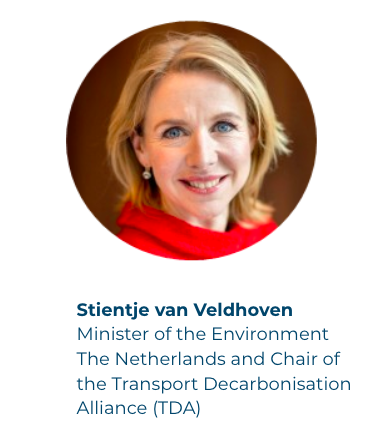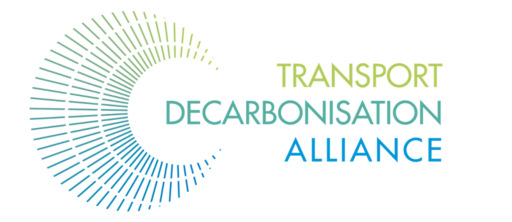Global Push to Reach 100% New Zero-Emission Truck and Bus
Sales by 2050 Unveiled
Who: Stientje van Veldhoven, Minister for the Environment of The Netherlands and Chair of the Transport Decarbonisation Alliance (TDA).
What: The Minister has invited policymakers worldwide to commit to accelerating the transition to zero-emission freight vehicles by developing a Global Memorandum of Understanding in 2021. The agreement setting ambitious targets for zero emission freight for 2030 and 2050 is expected to be signed and presented at COP26 in Glasgow, November 2021 by the largest possible group of signatories.
When & Where: Tuesday, 1 December 2020 17:00-18:30 CET 11:00-12:30 CST. The Minister will deliver a keynote during the virtual En Route to COP26 event, Session 3b: Is the End of the Internal Combustion Engine Coming for Freight?
Why: For the world to achieve Paris Agreement targets, the global transport sector will need to become carbon neutral by 2050. That means that at least 30% of freight vehicles will need to be zero-emission by 2030. Yet at the moment, transport emissions are rising: if current trends continued, emissions would more than double by 2050 compared to 2015.
The process to sign a global MOU at COP26 comes at an important transition point for the industry as an investment in zero-emission vehicle technology for the medium- and heavy-duty sector continues to ramp up with a growing number of tucks available at cost parity by 2030. This makes ZEF freight vehicles a compelling investment from many perspectives. Setting targets by a large group of signatories will give greater predictability and volume to markets.
The switch to zero-emission freight vehicles promises widespread health benefits, particularly in communities where heavy truck traffic has led to higher levels of air pollution. Investing in zero-emission trucks and buses, and charging and fueling infrastructure, will also create jobs while helping to build a clean, resilient economy.
Ambition and process
The Minister aims to have the widest possible group of signatories commit to the Global MoU at COP26. Signatories are expected to commit to working collaboratively to advance and accelerate the market for zero-emission medium- and heavy-duty vehicles. These vehicles include large pickup trucks and vans, delivery trucks, box trucks, school and transit buses, and regional- and long-haul delivery trucks.
This process has a solid basis. In July 2019, 15 U.S. states and the District of Columbia joined forces to accelerate bus and truck electrification. They signed a memorandum of understanding, pledging to eliminate sales of new diesel-fueled vehicles by 2050. The launched process will build on this in its ambition to achieve a large global coverage with similar ambition.
To provide a framework and help coordinate efforts by signatories of the MoU, the signatory jurisdictions will work through the existing Clean Energy Ministerial Campaign under the Electric Vehicle Initiative, the “Global Commercial Vehicle Drive to Zero program (Drive to Zero).” CEM-EVI-Drive to Zero stands ready to serve as a forum for coordination, collaboration and information sharing on market-enabling actions, research, and technology developments.
A review of progress will take place at the World Economic Forum Annual Meeting, in May 2021.
Parallel action in the private sector
For non-state actors, a freight-specific campaign will be launched in January under the UN Race to Zero campaign. Private-sector commitments from fleet owners and operators, manufacturers (OEMs), infrastructure providers, and financial institutions will be developed in the following months.
Context: The global transportation sector is a large source of greenhouse gas emissions and also contributes to unhealthy levels of smog. Heavy-duty vehicles account for a disproportionate share of oil consumption, greenhouse gas emissions, and air pollution, and thus represent an important target for emissions control.
Freight transport is responsible for 8% of global CO2 emissions according to the ITF Transport Outlook 2019, with 62% of freight transport emissions being generated from road freight. At the current rate, emissions will more than double by 2050 compared to 2015.

‘The temperature on earth is increasing faster than we thought. Zero-carbon transport worldwide is essential to keep climate change in check and meet our Paris Agreement ambition. If we want all our transport to be carbon neutral by 2050, we know we need at least 30% of new freight vehicles to be carbon neutral by 2030. So we will need to speed up and accelerate the market for zero-emission vehicles. Rallying the largest possible group of countries behind these targets is why I launched this Global MoU process and expect a large coalition of countries to have signed by COP26.’

“No one nation alone can change the course of the global truck and bus sector’s increasing climate and air quality impacts” said Bill Van Amburg, Executive Vice President of CALSTART and its Global Drive to Zero campaign. “But together we can. By working collaboratively we can send the most effective and globally-aligned market signals, via common goals coupled with smart and supportive policies, regulations, incentives and investments, to cause this change. Drive to Zero is proud to coordinate this effort. The Global MOU allows us all to pull together in the same direction, at the same time – and speed the pace of decarbonization.”
